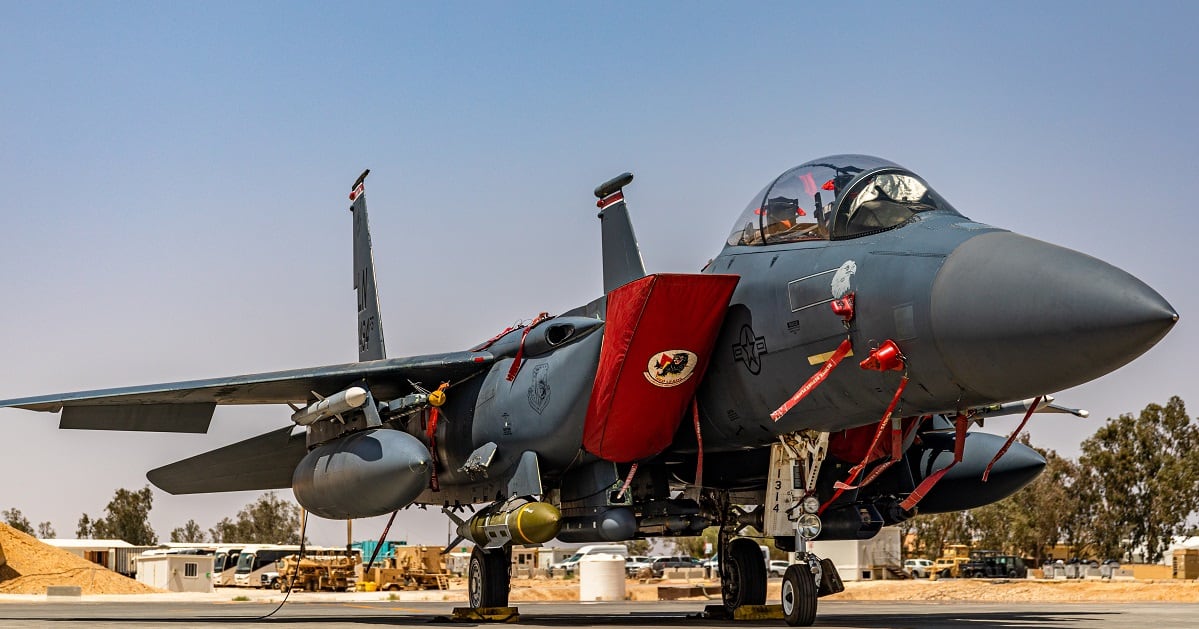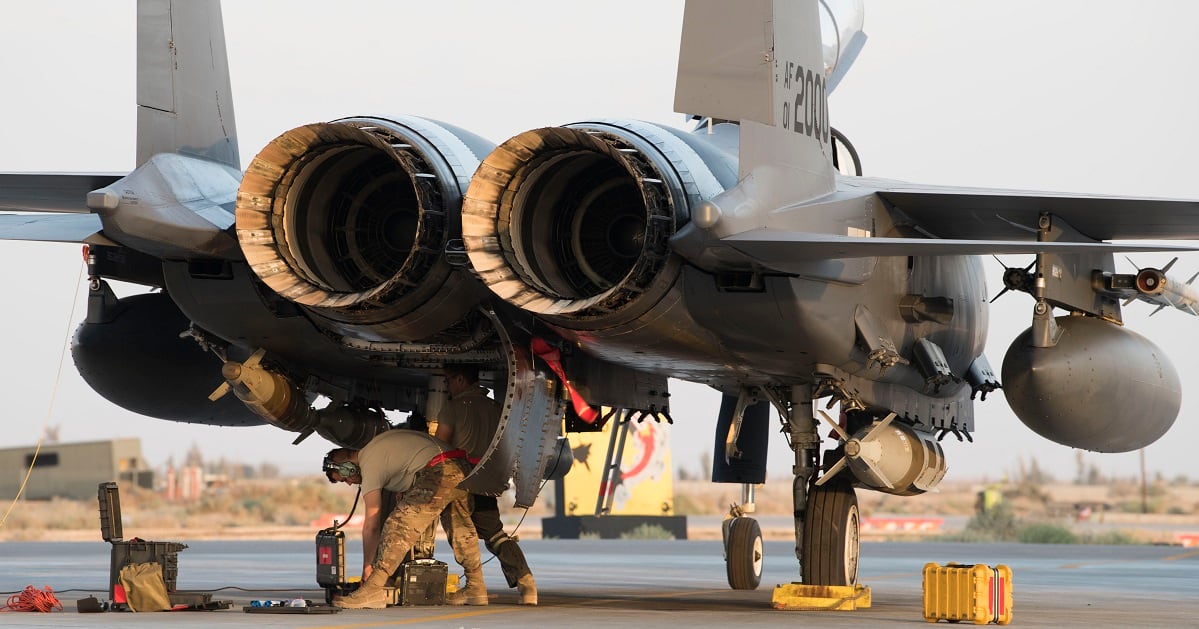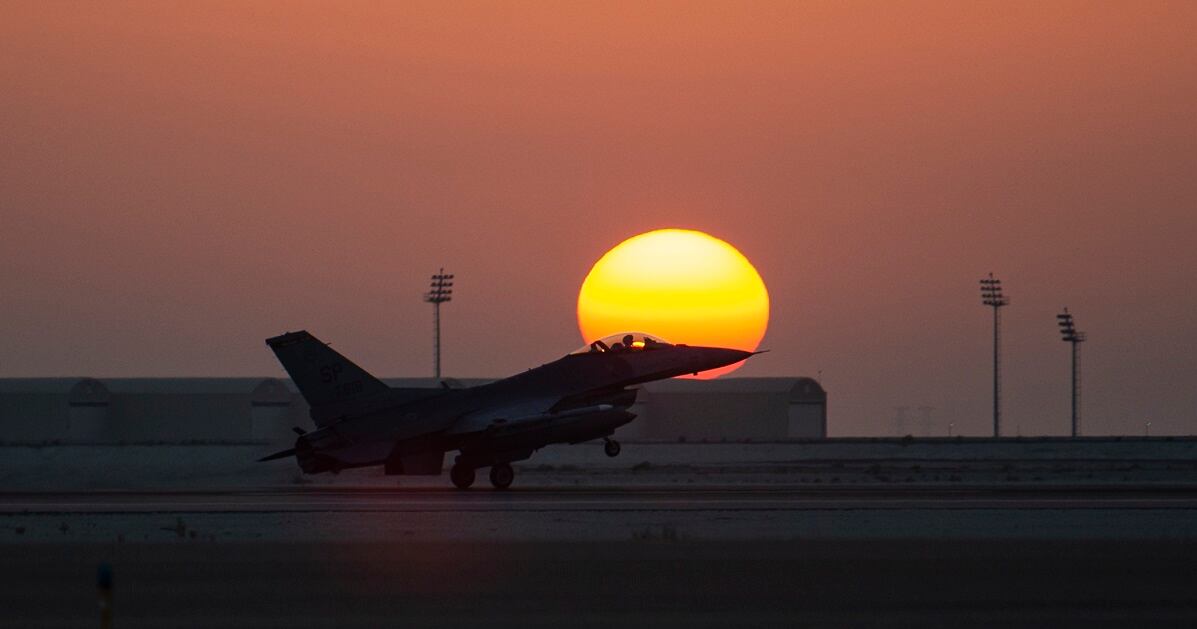The Air Force’s latest push for a more flexible force — known as agile combat employment — could help the service keep airmen at home longer and its aircraft readiness up, the leader of a key expeditionary wing in the Middle East told Air Force Times April 30. But deployments could become more intense for airmen when they do go abroad.
Adopting ACE into regular operations across the force would likely increase the pace and frequency of missions, said Brig. Gen. Larry Broadwell, commander of the 380th Air Expeditionary Wing at Al Dhafra Air Base in the United Arab Emirates.
But that’s not the only measure of military prowess — it’s also about efficiency. The service wants to outsmart its adversaries and limit geographic weaknesses without sending many more people overseas.
Last week, the 494th Expeditionary Fighter Squadron out of RAF Lakenheath, England, touted its first attempt to use multiple fighter jets as munitions trucks on April 25 while en route from an undisclosed location to Al Dhafra.
Six F-15E Strike Eagles carried 12 GPS-guided Joint Direct Attack Munitions, double their usual load. The squadron calls it their “have bombs, will travel” configuration.
“We were asked to come out and support combat missions with a very short turnaround, and with the bombs not being built previously here for us,” Capt. Jessica Niswonger, a weapon system officer and mission planner at the squadron, said in a release. “By carrying more bombs than we’d actually carry to drop, we’re setting up the initial days of combat.”
While the excess weapons aren’t meant to be fired in a combat operation, using a fighter jet as an airlifter can lessen a unit’s reliance on busy transport planes. After ferrying munitions to their destination, the weapons can be loaded onto other aircraft that are ready to head out to the battlefield.
Agile deployments move faster when airmen are trained in multiple skills outside of their typical job. It takes about three hours to ready a fighter jet to go again after it returns from an ACE mission, Chief Master Sgt. Timothy Mackey of the 494th Expeditionary Aircraft Maintenance Unit told Air Force Times. The more people who can do the job of a crew chief, for instance, the faster a jet can get back in the air.

Units are still refining what kind of cross-training they want to pursue to support ACE without overwhelming people — for instance, whether a maintainer should be pulling double-duty with security forces when needed, or if the maintainer should know how to care for multiple kinds of planes.
That flexibility can help the United States keep up with its military objectives in the Middle East and elsewhere, as American troops withdraw from Afghanistan and combat needs change around the globe.
Broadwell pointed to a Europe-based unit that came to CENTCOM several months ago and hopped around the globe.
“They were here in CENTCOM, but before they made it back to [U.S. European Command], they were actually tasked and they supported operations in [U.S. Africa Command],” he said. “Perhaps the tempo wasn’t enhanced, but they were available to do things that no one else was available to do just because they were here.”
Shuffling airmen around multiple continents for missions on top of their original tasking is no small feat — and could risk burning out troops even more after decades of nonstop combat.
Broadwell said the difficulty of preparing airmen to take on flights as needed will depend on how well they’re trained for rapid deployments and what they’re asked to do. Sometimes it’s a two-day, out-and-back mission; other times it’s traveling somewhere undeveloped and new for at least a month of continuous combat operations.
It’s unclear how long airmen might typically spend on ACE missions without returning to home base, but the service is moving toward packing more sorties into shorter deployments.
Limiting deployment time can help jets stay ready for flight ops while still giving regional commanders the airpower they want, he added. That can translate to larger organizations like his own air expeditionary wing as well.

“We’re still kind of discovering what that [mission time] cutoff would be, or some general rules to use,” Broadwell said. “Our recent track record continues to prove that ACE is very effective at delivering on the combatant commander objectives and returning the unit in a higher state of readiness.”
Figuring out how to adjust the logistics train of parts, refueling equipment, maintenance crews and other assets the Air Force needs to keep its planes flying is a bigger challenge that’s still in the works.
And while a large fleet of jets like fighters can more easily spread aircraft around the world, smaller groups of planes tasked with missions like intelligence collection will have a harder time being available for agile deployment demands, Broadwell said.
“In large measure, much of what we’re learning about sustainment and maintaining and operating these platforms, a lot of it is actually transferable,” he said.
RELATED

Another issue the Air Force faces as it tries to decentralize combat ops is how to direct units that are moving around more than in the past. He predicts wings will have to take on more command-and-control responsibilities to keep up over time.
“This depends on the pace of activity, the volume of the number of units that we’re talking about,” Broadwell said. “We could exceed traditional [Combined Air Operations Center] capacity, just with the sheer number and the C2 requirements if we started moving people all around the theater.”
Deployments longer than a few months wouldn’t be completely off the table, however. Sometimes getting a job done requires sticking around as long as is needed, Broadwell said. But the Air Force could still limit its dependence on a network of brick-and-mortar bases.
“Back in the day, an air expeditionary wing really was expeditionary,” Broadwell said, noting that Al Dhafra has supported U.S. Air Force operations in CENTCOM since 1990. “It’s hard to say I’m expeditionary when I’ve been here 30 years.”
Rachel Cohen is the editor of Air Force Times. She joined the publication as its senior reporter in March 2021. Her work has appeared in the Washington Post, the Frederick News-Post (Md.), Air and Space Forces Magazine, Inside Defense, Inside Health Policy and elsewhere.




